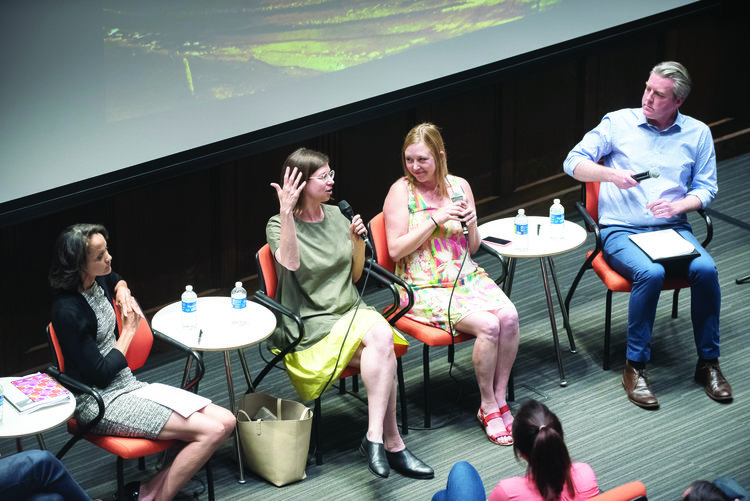
More than 100 Silver Lake residents gathered in Occidental College’s Choi auditorium April 19 to discuss the future of their town’s water reservoir. The final session of 3rd LA: City on the Verge, titled “96 Acres: Designs on the Silver Lake Reservoir,” was dedicated to discussing the repurposing of the Silver Lake reservoir in Los Angeles. The event was one of 18 talks given since the initiation of the 3rd LA series in 2015.
Panelists included Alexander Robinson, assistant professor of the University of Southern California’s Landscape Architecture Program and principal of the Office of Outdoor Research, Ann Marie Johnson, co-chair of the Silver Lake Neighborhood Council, Catherine Geanuracos, co-founder, treasurer and secretary of Silver Lake Forward and Alissa Walker, urbanism writer and editor for Curbed Los Angeles.
The Los Angeles Department of Water and Power (LADWP), which owns and maintains the reservoirs in the Los Angeles area, announced December 2007 that the Silver Lake reservoir and the neighboring Ivanhoe reservoir had both been contaminated by exceptionally high levels of the cancerous, sunlight-produced chemical bromate. Both reservoirs were drained March 2008 and refilled May 2008, according to the LADWP website. The Ivanhoe reservoir was eventually layered with black, hollow, plastic shade balls to prevent the resurgence of bromate levels in the water. When sunlight mixes with chlorine and bromide, the carcinogen bromate forms. The shade balls function to stop the sunlight from mixing with these chemicals and this process from occurring. Meanwhile, the Silver Lake reservoir remained out of order.
In 2015, under the Headworks Reservoir Project, LADWP drained the Silver Lake reservoir a second time, making it unstable as a water source. In the two years since, community members, city officials and LADWP have been conflicted regarding how and whether to repurpose the now obsolete reservoir, Hawthorne said. Based on differing perspectives, Silver Lake residents have formed groups on how these 96 acres of land would best serve and reflect community interests. According to Hawthorne, some residents say the reservoir should be refilled immediately, while others think no plan of action should be taken before reaching a consensus. Organizations such as Los Angeles Forward have brought forth comprehensive proposals that envision recreational water sports, walkways and more diverse aquatic life.
Geanuracos believes that refilling the banks would allow residents to beautify the area surrounding the lake and beyond it, making it more welcoming to wildlife and conducive to recreational water sports. Walker mostly agrees with Geanuracos but appealed to issues of public space and whether city officials oppose this plan simply because they want to prevent an influx of people to Silver Lake. Johnson is supportive of the current efforts to refill the reservoir in the following months while Robinson agreed that beautifying and repairing the landscape, which currently resembles marshland, would best serve the community.
Some Silver Lake residents are preoccupied with maintaining the location’s wildlife and are resistant to the potential urban changes, according to Hawthorne. There are several proposals that would involve turning the land into a park or green space, which would require driving out the ecosystems that currently inhabit the area.
Other Silver Lake residents consider the vacant land an opportunity to create a more inviting space, one that will be open to people from all over LA county. Joe Henkens, Silver Lake resident, hopes to see the reservoir repurposed to provide the neighborhood with a more inviting space that would increase civic engagement and would welcome residents and commuters alike.
Amy Pino (junior) viewed the discussion as unproductive and said most participants seemed to be set in their opinions of what the future should be.
“I was personally a little disappointed to see that some Silver Lake residents were so adamantly opposed to the idea of turning it into low income or affordable housing, just because it’s such a large piece of land that could be used in a lot of great ways if residents were actually open to having a conversation about it,” Pino said.
Silver Lake residents can agree on one thing — they want the 96 acres of land to be representative of their community’s future — what remains unclear is what that future will look like.
The 3rd LA series, a sequence of discussions in an ongoing conversation concerning the past, present and future of LA, is led by Urban & Environmental Policy (UEP) Professor Christopher Hawthorne. These conversations, which have become an Occidental tradition, function as a component of the UEP 308 class titled “The Third Los Angeles Project” taught by Hawthorne each spring.
Hawthorne expressed that his intention with the 3rd LA series is to find topics that challenge landscape architecture in their intricacies and multifacetedness.
“I’m especially interested in finding subjects that are emblematic of larger questions faced by LA and Southern California — subjects that allow us to take some measure of our civic identity and ambition and of the anxieties that so often accompany growth and change,” Hawthorne said.
Have a pitch? Email us at weekly@oxy.edu or tweet us @OxyWeekly.
![]()


































